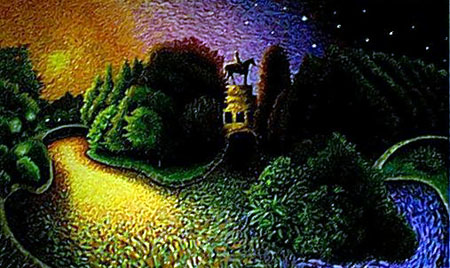
"MIRA: Chicago Artists of HispanicHeritage" is an exhibition that features the artwork of Latino artists that live and work in the Chicago metropolitan area. The Chicago Athenaeum at Schaumburg intends to explore the variety of the artists' work while celebrating the Hispanic art community's important and vital contribution to Chicago's exciting metropolitan culture, as well as it's influential national and international significance.
"MIRA" is defined as an art exhibit featuring paintings, installations, prints, drawings, and sculpture by artists of Hispanic heritage. The artists' styles and the content of their work are diverse. Some of the artists incorporate identifiable ethnic and mythological imagery in their pieces that is traditionally associated with the Latin American artistic and cultural tradition. Others communicate universal themes or are abstract and devoid of subject altogether. Some artists express relevant terrestrial and social themes; while others express transcendental, shamanistic visions.
Exhibiting artists for "MIRA"
include Jose Aleman (sculpture) MarioCastillo (paintings) Juan
Compean (paintings), Carlos Cortez (wood block prints), Miguel
Cortez (paintings), Esperanza Gama (prints), Oscar Romero (paintings),
Riccardo Santos Hernandez (paintings), and Paul
Sierra (painting).

MARIO CASTILLO. At present I am going through a transitional period, similar to one I went through in 1974. This has to do with recapitulating, reclaiming, and revisiting work from my own personal artistic past. I am doing this as a form of cleansing and because I know it will take me to new levels of awareness. An exhibit at The Frick Center, at Elmhurst College, (running through October 20, 2001) is called "Recapitulations and it demonstrates my intentions clearly
The work with layering images over each other actually goes back to work I was doing in 1961. The idea for the superimpositions came from cave art. Some of these paintings deal with "Perceptualism" a term I coined in 1993. This deals with altering your perception. By focusing on the pupil of an eye or the middle of concentric circles for ten seconds or more your perception starts to change and the painting starts to act as a Rorschach ink blot and you start to see things I did not put there. With longer focused observation, the work starts to turn into an apparent field of energy.
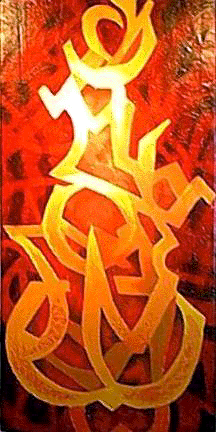
JUAN COMPEAN. The three paintings are the beginning of a new series of work. Earlier this summer I was playing around with some old typography assignments from college. In one of the projects we were overlapping typefaces over each other after spacing out on those designs; images began to form out of the patterns. One of the first images to appear was "Fuego, it reminded me of crazy looking flames, so I put it to canvas. The other two paintings were created the same way. Inspiration also comes from neighborhood graffitti, feelings, thoughts and images from everyday life.The fourth piece, "Corporate Greed, dates back a few years but never fails to lose meaning. It was intended to voice the feelings of co-workers at a factory that I worked at for a while. It also serves as a self-portrait of sorts. Unfortunately I am the chimp, putting in long hours and in sometimes, dangerous conditions.
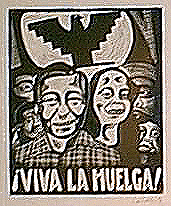
CARLOS CORTÉZ began as a painter and turned to linoleum prints in the late 1950s. The artist recalls that in the 1970s and 1980s the price of linoleum kept rising, and it was then that he turned to woodcuts using any type of wood available, even discarded cabinet doors and desktops. Wood has a character of its own, complete with knots and flaws as well as serendipitous fine grains and suggestive flows. The difficulties and rewards are multiplied when the wood has been previously fashioned or set by a prior use. Although art and message are foremost for Cortéz, he has developed a rapport with wood. His woodcuts display a finer, more concentrated working than materials such as linoleum. The linoleum prints often show a greater economy of image; direct, strong and more stylized. He has been described as self-taught, but it is perhaps more accurate to say that over many years his materials and his talent have taught him, and given him the language for his beliefs and feelings. The art and man are one; at times advocate and at times observer. They contain both manifesto and poetry, in short, language.
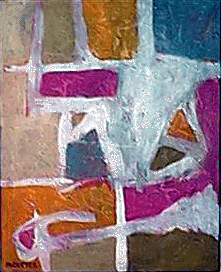
MIGUEL CORTEZ. I am a visual artist living in Chicago and born in Guanajuato, Mexico, and have exhibited my work extensively throughout Chicago and Mexico over the past 12 years. I studied painting at the School of the Art Institute and film making at Columbia College.
My style of painting has evolved and changed over the years. It began as a sort of figurative surrealist frottage with a dark use of colors. It changed to a more abstract and slowly turned more colorful yet with a very organic aged look to it. On some of the new abstract paintings you can imagine the forms being either a close up of something microscopic or an aerial view of imaginary
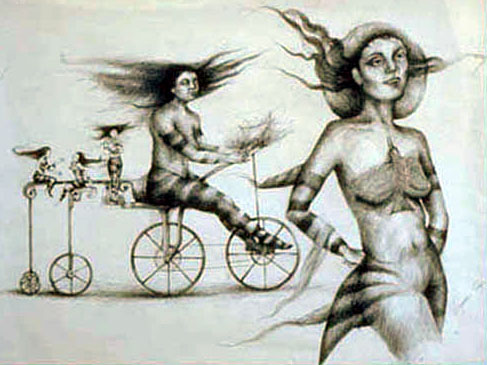
Emotions are best expressed by the direct contact of the human eye. Theability to see was my primary ambition at the beginning of my artistic career. Another very interesting form of expression to me was to try to metamorphosize the mystical images of dreams into inspiration for my work.
In recent years I have become intrigued by the mysteries of other people's lives. By consequence, I have developed an interest in reading biographies that often do not include photographs. By reading such books one has the opportunity to imagine the visual history without someone else's interpretations. This interest took shape in my last solo exhibit entitled "Mujeres de Cuatro Siglos" ("Women of Four Centuries") and was my artistic biography of women of the last four centuries.
I am a professional independent artist. I consider myself a graphic artist whose art incorporates different techniques. Magic Realism best describes what I wish to represent in my artwork. I have studied the classical artists of the Renaissance and Surrealist movement, and both have influenced my artistic development.
JESUS AVILA-MACARENA. The works exhibited, "DNA I and "Maya-DNA, are from a body of work entitled "Magnetic Flesh. I focused my attention on post-colonialism in genetics. One issue that I address is biopiracy, where multinational corporations feel that it,s their "natural right to patent DNA or genetic information for commercial use. For example, corporations have patented DNA from indigenous populations in Central America. I hope my work opens venues for discussion on issues similar to biopiracy.
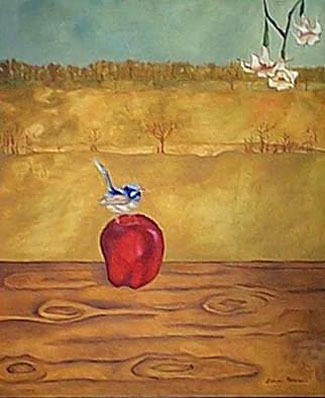
While trained as a sculptor, Dolores Mercado has confined herself to working mostly on paper for the last four years. Her work is often small, detailed and intimate while creating a feeling of dreamlike settings almost to the point of becoming surreal. Innately figurative, her works emanate an almost poetic sense, probably inspired by her great love for literature and poetry, and a deep appreciation for humankind."
Mercado studied at Mexico City's National School of Painting, Sculpture and Printmaking "La Esmeralda" from 1985 to 1990. In the following years, she worked as a restorer of paintings (colorist), taught children sculpture at the Ecological Foundation "El Manantial" in Mexico City and stone carving workshop for children in Puebla, Mexico. Her works were reproduced in "Luvina" (the art journal of the University of Guadalajara, Mexico) in 1994 and1996. Since her move to Chicago in 1996, Mercado has been exhibiting her two-dimensional work in the Chicago area. She has exhibited in individual and collective shows in Mexico City, Toluca and Guadalajara in Mexico; the Chicago area; and Cordoba, Spain. She currently conducts a live cultural radio program on a weekly basis at WRTE and works as Museum Arts Educator for the Mexican Fine Arts Center Museum.
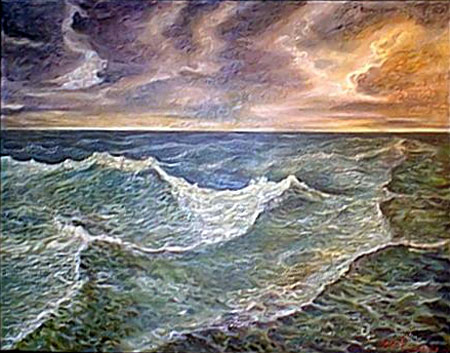
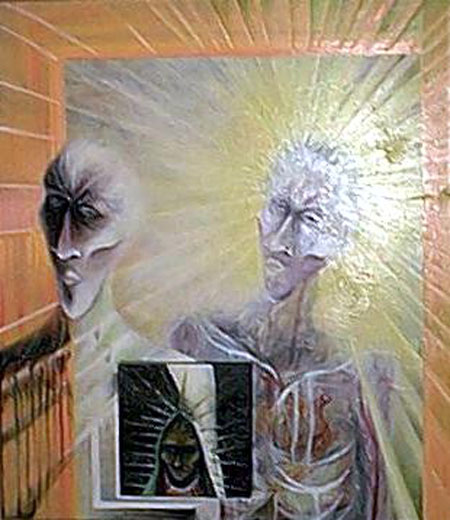
The work that I have included
for this exhibition narrates three themes. One of those themes
is Sea Ania (Flower World), the World Underneath the World. Sea
Ania, in Yaqui belief, describes a place underneath the ground
that our ancestors inhabit. It is believed that many of our ancestors,
the Surem, returned to Sea Ania before the arrival of the
Spaniards to the desert area of southern Sonora for they knew
that many changes and hardship would take place and that life
would not be the same once these visitors came.
This world is described as a place of enchantment and magic. It is believed that most of the desert animals that inhabit the desert are our ancestors. They are considered medicine people of power. The magical creatures that you see in the painting The Macho Man Arrived, makes references to this place of enchantment.
The second theme that I have explored since my arrival to Chicago is the environmental chaos and industrialism that surrounds this city of a few million people. The painting Consumer Man makes a commentary of the contaminated landscape and forest of smokestack erections that dominate the urban skyline and neighborhoods.
Catholic icons like the Virgin of Guadalupe are a recent exploration in my work that alludes to the evangelization of the desert people 400 years ago who lived in the areas known today as Sonora and southern Arizona.
I have explored these themes extensively
since I came to the windy city to attend The School of the Art
Institute of Chicago for graduate school. To be away from the
beauty and stillness of southern Arizona and the desert landscape
makes me think deeply about the environment in
which I presently live. In the painting Consumer Man I became
one more contributor to the environmental chaos that is wasting
us.
